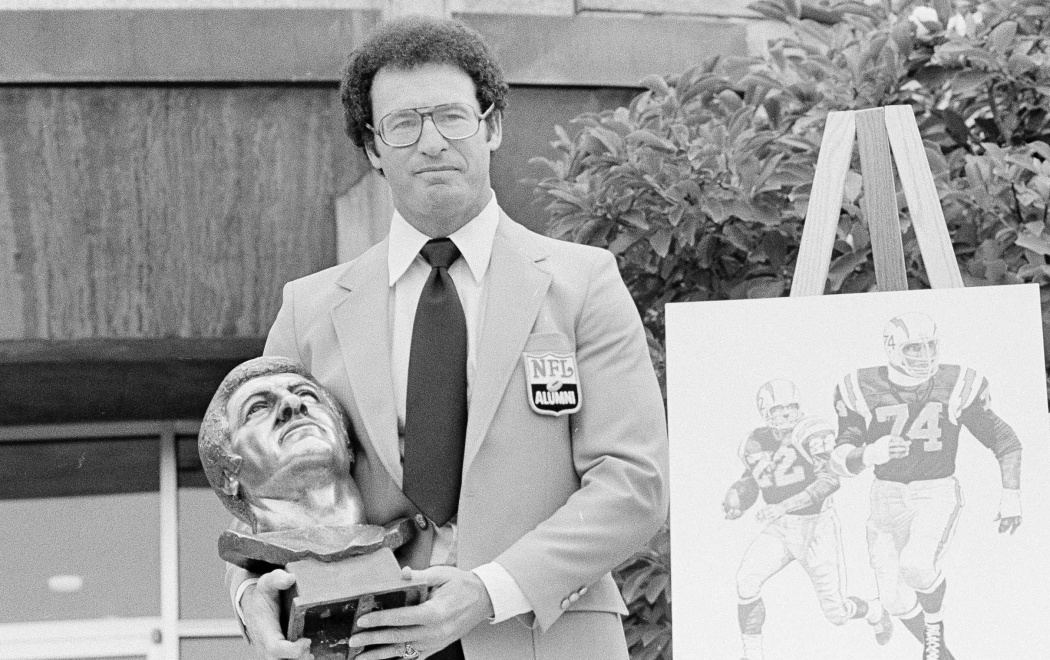Gold Jacket Spotlight: 'Late Developer' Ron Mix

Anyone who considers himself or herself a potential “late bloomer” should place Ron Mix on a personal list of inspirational sports figures. He’s living proof that one opportunity can open the door to greatness.
Projecting that Mix, who this week steps into the Gold Jacket Spotlight, could reach the Pro Football Hall of Fame when he was playing at the high school level would have produced plenty of laughs – some from Mix himself.
A few twists of fate, and the self-discipline and dedication Mix possessed to pursue his dream, changed his life’s path.
As a two-way end at Hawthorne High School in California, Mix was a gangly teen – about 6-foot-2 and 168 pounds – buried on the depth chart until his senior season, when he finally became a starter. Even then, he managed to snag only honorable mention status on his league’s postseason all-star team.
“It was the equivalent of a participation ribbon,” Mix has said in interviews recalling his early years in football.
When it came time to select players for a game pitting all-stars from two California leagues, however, all the ends who were more celebrated than Mix were underclassmen, thus ineligible to play. The door was ajar, and Mix was about to burst through it.
With several months to work out before the game, Mix hit the weight room – typical now but unusual in the mid-1950s. The results were fast and dramatic.
Mix, a self-described “late developer,” said he “blossomed.”
By the time the game was played, Mix had transformed into the standout on the field. That singular performance caught the eye of a University of Southern California scout in the stands and the rest, as they say, is history.
After that breakout game, Mix continued to develop physically and by 1959 was named first-team All-America at offensive tackle for USC. No more participation ribbons for someone who stood 6-foot-4, weighed about 250 pounds and could press 300 pounds overhead and more than 400 on the bench while quick enough to lead sweeps around the end and pass block with equal efficiency.
In 1960, both the Baltimore Colts (National Football League) and Boston Patriots (American Football League) drafted him. Making it clear he wouldn’t go east to play in the new AFL, Boston traded his rights to Chargers, who were based in Los Angeles that inaugural season.
The Colts offered $8,000 a year and a $1,000 bonus. The Chargers offered $12,000 and a $5,000 bonus. Even with his heart in Los Angeles, Mix’s head suggested he go to the NFL.
“I told the Colts that if they'd give me $10,000 and $2,000, I'd sign with them,” Mix told the L.A. Times in a retrospective on his career. “They said no. … So I signed with the Chargers.”
One year became 10, and Mix played every one of the AFL’s seasons with the Chargers, helping them win five Western Division titles and the 1963 AFL Championship, a 51-10 rout of the Patriots.
Mix retired after an injury-affected 1969 season that limited him to eight games. He wanted to rejoin the Chargers in 1971, but instead the team traded him to Oakland for two draft picks. He appeared in 12 games with the Raiders, then retired again and entered the legal profession. He was a nine-time All-AFL selection and a member of the AFL Hall of Fame All-1960s Team.
“He was the best offensive lineman I've ever seen,” Hall of Fame coach Sid Gillman said of Mix. “There was nothing he couldn't do.”
Stories From The Hall of Fame Archives: In Search of Missing Piece
Some free agents take new team to new heights.
The Mission Featuring Sarah Thomas, NFL Official
In honor of Women’s History Month, HOF Productions celebrates the excellence of Sarah Thomas.

